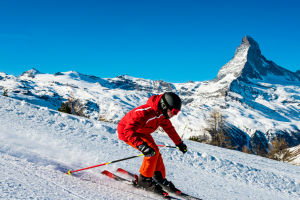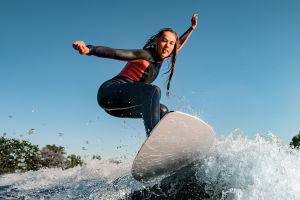Skiing down a snowy slope, feeling the wind rush by, is one of the most exhilarating experiences you can have on the snow.
If you're a beginner, though, this thrill might seem far away, but with the right preparation and techniques, you'll soon be carving your way down the mountain.
Whether you're gearing up for your first ski trip or just curious about the basics, this guide will help you gain confidence and skills for a safe and fun skiing experience.
HOW TO Improve Your Skiing With 3 SIMPLE TIPS
Video: Carv - Digital Ski Coach
1. Getting Your Stance Right
As beginners, we often struggle with the basic posture on skis. The first step to mastering skiing is learning how to stand properly. When we're nervous or unsure, we tend to stiffen up, but relaxing is key. Start by standing on flat ground to get comfortable with the skis. Focus on keeping your weight balanced, shifting your center of gravity slightly toward the lower half of your body. Also, lean a little forward, ensuring that your knees are slightly bent. Once you feel stable, you can start practicing these movements on a gentle slope.
2. Moving Forward
Now that we've got our stance, it's time to learn how to move forward. Skiing is all about control and balance, so take it slow. We can use ski poles for extra support, especially when you're just starting out. To move, position your skis in a parallel direction and gradually push yourself forward. It's important to relax your upper body, keep your eyes looking ahead, and gently glide in a straight line. As you get more comfortable, you can start increasing the distance and speed of your gliding practice.
3. Turning on the Slopes
Turning while skiing can seem daunting at first, but once you understand how to use your body's weight, it becomes second nature. If we want to turn left, we shift our weight to the right leg, using the right foot to steer. Conversely, for a right turn, we shift our weight to the left leg and use the left foot. During turns, we need to keep our body posture slightly leaning forward to maintain balance, but we should avoid unnecessary movements with our upper body. Also, always keep your eyes on the path ahead, not looking down, as this helps prevent you from losing balance and falling.
4. Learning the Snowplow Stop
The snowplow stop (also known as the "pizza" stop) is a must-know technique for beginners. This technique allows us to control our speed and safely come to a stop. To practice, slightly bend your knees and shift your weight forward. Then, angle your skis inwards, forming a “V” shape. Adjust the width of the V to control the level of braking—widen it for a stronger stop or narrow it for a gentler deceleration. When you first start learning, practice on flat or mild slopes until you're confident, and then try it on steeper slopes.
5. Falling Correctly
As much as we hope to stay on our feet, falls are part of the learning process. The key is not to be afraid of falling but to learn how to fall safely. Falling incorrectly can lead to serious injuries, like spraining wrists or worse. The best way to fall is to let your body fall sideways. Try to avoid extending your arms to break the fall, as this can lead to wrist injuries. Keep your head facing uphill and your skis pointing downhill when you fall. After you fall, use your poles or the snow to help you gradually get back up.
Wrapping Up Your Ski Experience
Skiing can feel intimidating at first, but with the right techniques and mindset, it's an incredibly rewarding sport. Keep practicing the basics, like posture, balance, and control, and before long, you'll be gliding down the slopes with ease. Remember, falling is just part of the journey, so don't get discouraged—just focus on getting back up and trying again. Take it step by step, and soon, skiing will feel like second nature. So, are you ready to hit the slopes? Happy skiing, Lykkers!


